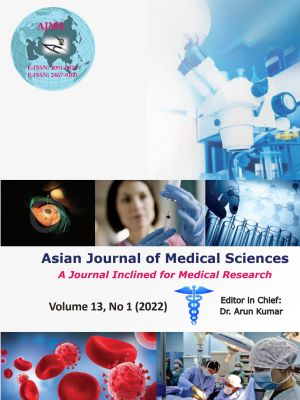Correlation of biofilm production with antibiotic susceptibility pattern of Pseudomonas aeruginosa from various clinical specimens
Keywords:
Antibiogram, Biofilm, Microtiter plate method, Pseudomonas aeruginosaAbstract
Background: Pseudomonas aeruginosa is one of the most prevalent nosocomial pathogens that cause a life-threatening infection. One of the important characteristics of P. aeruginosa is biofilm formation which leads to antibiotic resistance.
Aims and Objectives: The aim of the study was to study the antibiotic resistance pattern of P. aeruginosa isolates and correlation with their biofilm-production.
Materials and Methods: A total of 87 P. aeruginosa isolates from different clinical specimens were processed and confirmed by conventional microbiological methods as per standard methodology. Antibiotic sensitivity testing was done for all isolates. Biofilm producing isolates were identified by the microtiter plate method (MTPM).
Results: Of 87 P. aeruginosa isolates, majority were from pus 33 (38%), followed by urine 26 (30%), sputum 19 (22%), body fluids 7 (8%), and blood 2 (2%). Biofilm producing isolates showed more resistance in comparison to non-biofilm producers. The observed difference between biofilm formation for multidrug resistant and susceptible isolates was found to be statistically significant.
Conclusion: MTPM method was an effective test for detection of biofilm formation and was also able to verify biofilm production by P. aeruginosa. This indicated a higher propensity among the clinical isolates of P. aeruginosa to form biofilm and revealed a positive correlation between biofilm formation and antibiotic resistance. This indicates the need for testing of even susceptible isolates for virulence factors such as biofilm production.
Downloads
Downloads
Published
How to Cite
Issue
Section
License
Copyright (c) 2021 Asian Journal of Medical Sciences

This work is licensed under a Creative Commons Attribution-NonCommercial 4.0 International License.
Authors who publish with this journal agree to the following terms:
- The journal holds copyright and publishes the work under a Creative Commons CC-BY-NC license that permits use, distribution and reprduction in any medium, provided the original work is properly cited and is not used for commercial purposes. The journal should be recognised as the original publisher of this work.
- Authors are able to enter into separate, additional contractual arrangements for the non-exclusive distribution of the journal's published version of the work (e.g., post it to an institutional repository or publish it in a book), with an acknowledgement of its initial publication in this journal.
- Authors are permitted and encouraged to post their work online (e.g., in institutional repositories or on their website) prior to and during the submission process, as it can lead to productive exchanges, as well as earlier and greater citation of published work (See The Effect of Open Access).




